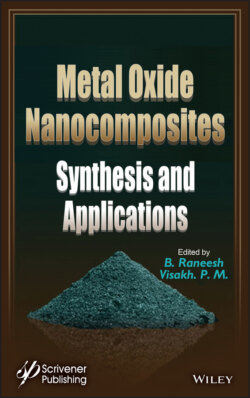Читать книгу Metal Oxide Nanocomposites - Группа авторов - Страница 17
1.5 Metal Oxide Nanomaterials for Sensor Applications
ОглавлениеResearch into imidazole chemistry has been quite comprehensive, single-site functionalizations and substitution as well as various annulation strategies has been well documented [89]. Recently, the interest in this heterocyclic system has been widened as it is a precursor to a class of compounds, called room temperature ionic liquids. Microwave-assisted synthesis of the substituted imidazoles on a solid support under solvent-free conditions in a three-component reaction [90] and efficient synthesis of imidazoles from aldehydes, 1,2-diketones and ammonium acetate in acetic acid have been reported [91]. Noble metal Au, Ag, or Pt coated ZnO is important for photoelectron transfer (PET) in the bulk and interface of ZnO semiconductors. Under illumination of UV light, the exciton absorption bands of ZnO are strongly bleached due to the accumulation of conduction band electrons. Thus, the efficiency of both the photocatalysis and photoelectric energy conversion can be greatly enhanced by depositing noble metals on the surface of ZnO [92–94]. The principle terms involved in a photoactive semiconductor are conduction band (CB), valence bands (VB), band gap, trap sites and Fermi level. The bands are the allowed energy states that an electron can occupy in a material. The highest energy band occupied by an electron is called the valence band while the next available lowest empty energy level, next to valence band is called the conduction band. The metal oxide samples were deoxygenated by bubbling with pure nitrogen gas. An ethanolic solution of the imidazole derivative of required concentration was mixed with nanoparticles dispersed in ethanol at different loading and the absorbance and emission spectra were recorded. The nanocrystals were dispersed under sonication in ethanol using ethylene glycol followed by dilution with ethanol. Surface modification of Fe2O3 has been performed as follows [95]. 2 g of Fe2O3 nanoparticles has been kept in a vacuum chamber at 110 °C for 75 min and then dispersed in acetone by stirring for 1 h at ambient temperature and finally has been sonicated for 20 min. Then, 1 g APTS (50 wt%) has been gradually added to the dispersed solution and stirred for further 24 h at ambient temperature.
Fluorescence enhancing arises due to formation of APTS–ZnO complex. The energy transfer competence is related not only to the distance between the acceptor ZnO and donor APTS (r0) but also to critical energy transfer distance (R0). The critical energy transfer distance (R0), , where, K2 is the spatial orientation factor of the dipole, N is the refractive index of the medium, φ is the fluorescence quantum yield of the donor and J is the overlap integral of the fluorescence emission spectrum of the donor and the absorption spectrum of the acceptor. On the relative positions basis of APTS and interfacial energy levels, the interfacial electron injection would be thermodynamically allowed from the excited singlet of APTS to CB of ZnO. On lighting at excitation wavelength both the APTS and ZnO are excited. Dual emission is anticipated due to LUMO → HOMO and CB → VB electron transfer. The probable is electron jump from the excited APTS to ZnO. Electron in LUMO of the excited APTS is of higher energy compared to that in the CB of ZnO. The inorganic nano size fillers with organic functional groups that attach to their surface by strong chemical bonds can be finally obtained. The interaction increases the surface tension of inorganic nano particles results f-ZnO. Binding interaction studies of NiO with AMB shows the unexpected results. The increased absorption observed with the dispersed NiO is due to the adsorption of AMB on the surface of NiO. Fluorescence enhancement resulted while adding the NiO to AMB. Azomethine nitrogen is involved in the binding process with Ag3O4 nanoparticles which was proved by molecular electrostatic potential. Morphological changes of Ag3O4 nanoparticles to AMB modified Ag3O4 nanoparticles confirm the binding of Ag3O4 nanoparticles to AMB. EDX spectrum of AMB modified Ag3O4 nanoparticles shows incorporation of AMB to Ag3O4 nanoparticles. The interaction between AMB and Ag3O4 occurs through static quenching mechanism.
